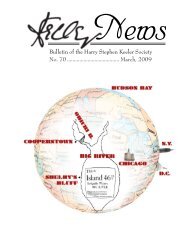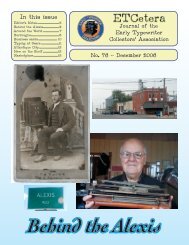John Newton Williams: The Untold Story - Personal Web Sites are ...
John Newton Williams: The Untold Story - Personal Web Sites are ...
John Newton Williams: The Untold Story - Personal Web Sites are ...
You also want an ePaper? Increase the reach of your titles
YUMPU automatically turns print PDFs into web optimized ePapers that Google loves.
screen. Try the different settings<br />
on your camera and see the re�<br />
sulting image sizes created. Small<br />
images will never satisfy other<br />
viewers who want to see your<br />
typewriters.<br />
Angle of shot<br />
Generally speaking, the angle of<br />
the shot will match the angle an<br />
observer would have, when stand�<br />
ing and looking at the typewriter<br />
on a desk. It is often best to shoot<br />
the typewriter turned sideways,<br />
to give depth of view and the side<br />
detail.<br />
Cropping<br />
Always crop the image to show�<br />
case the typewriter. It is best not<br />
to crop through a shadow.<br />
Photography is a creative pro�<br />
cess. Success comes from playing<br />
with and enjoying one’s camera<br />
and computer. Have fun and enjoy<br />
your results. ±<br />
In the next “Back to Basics”: an eBay<br />
primer.<br />
Tennessee <strong>Williams</strong>’<br />
Typewriters<br />
T his 1934 Underwood portable, serial 717166, sold for $3750 in December.<br />
Why? Because according to the auctioneers, it’s the very machine<br />
featured in this story told in Donald Spoto’s <strong>The</strong> Kindness of Strangers: <strong>The</strong><br />
Life of Tennessee <strong>Williams</strong>.<br />
On September 8, 1982, five months before his death, <strong>Williams</strong> was<br />
in a bar in Key Largo, Florida, where he struck up a conversation with a<br />
couple having coffee. When <strong>Williams</strong> found out that the husband, Steven<br />
Kunes, was a writer, he introduced himself and asked that they call him<br />
Tom. Eventually, the Kuneses drove him back to his home in Key West,<br />
where Steven Kunes told <strong>Williams</strong> about his novel in progress. “And<br />
that’s when it happened. <strong>Williams</strong> went into another room and emerged<br />
with a squ<strong>are</strong> black case, telling me to look inside. It was an Underwood<br />
typewriter… ‘I used it for Summer and Smoke and Cat on a Hot Tin Roof.<br />
It needs a new ribbon, and perhaps some oil... Write a play, Steven. Just<br />
write a play. I know you can hit the core... Don’t be flattered when I say<br />
this. You can flatter me by using this old machine to do the job.’”<br />
As Lucy Jacobs commented on the online Portable Typewriter Forum,<br />
“To me, this story just doesn’t fit <strong>Williams</strong>—he slept anywhere, wrote<br />
anywhere, threw the typed pages behind him (his agent had to rescue<br />
them)—he just had to be typing every morning at dawn. By 1955 (when<br />
Cat was written) he was no starving artist, so he could afford to pick up a<br />
new machine wherever he was. I think the seller might be telling the truth<br />
of what <strong>Williams</strong> told the man—but I bet the real story was that <strong>Williams</strong><br />
had an old typewriter and made up the story on the spot for dramatic<br />
effect.”<br />
One thing is sure: TW<br />
loved to use TWs, and to have<br />
himself photographed with<br />
them. Here we see a dapper<br />
Tennessee on a circa 1940 Corona,<br />
a humid Tennessee on a<br />
Royal KMM, and a fumaceous<br />
Tennessee with an Olivetti Studio<br />
44. ±<br />
ETCetera No. 73 / March 006 / 11





